Complete Solutions to All Questions of chapter RANK BOOSTER of Class 12 book with complete answers and questions
| Class 12 | CHEMISTRY |
| Chapter | RANK BOOSTER |
| RESONANCE | All Questions |
| Number Of Questions | 100 |
| Academic Year | 2023-24 |
The reduction potential of hydrogen half cell will be negative if :
02:32View SolutionA very thin copper plate is electro`-` plated with gold using gold chloride in `HCl`. The current was passed for `20 mi n`. And the increase in the weight of the plate was found to be `2g.[Au=197]`. The current passed was `-`
02:40View SolutionWe have taken a saturated solution of `AgBr,K_(sp)` of AgBr is `12xx10^(-14)`. If `10^(-7)` "mole" of `AgNO_(3)` are added to 1 litre of this solution then the conductivity of this solution in terms of `10^(-7) Sm^(-1)` units will be: [Given: `lambda_((Ag^(+)))^(@)=4xx10^(-3)Sm^(2)"mol"^(-1),lambda_((Br^(-)))^(@)=6xx10^(-3) S m^(2) "mol"^(-1),lambda_((NO_(3)^(-)))^(@)=5xx10^(-3)Sm^(2) "mol"^(-1)`]
09:40View SolutionAt what `[Br^(-)]/sqrt(CO_(3)^(2-)]` does the following cell have its reaction at equilibrium?
`Ag(s) | Ag_(2)CO_(3)(s)| Na_(2)CO_(3)(aq)|| KBr(aq) | AgBr(s)| Ag(s)`
`K_z9sp) = 8 xx 10^(-12)` for Ag_(2)CO^(3)` and `K_(sp) = 4 xx 10^(-13)` for AgBr04:05View SolutionConsider the cell `Ag(s)|AgBr(s)Br^(c-)(aq)||AgCl(s),Cl^(c-)(aq)|Ag(s)` at `298 K`. The `K_(sp)` of `AgBr` and `AgCl`, respectively are `5xx10^(-13)` and `1xx10^(-10)` . At what ratio of `[Br^(c-)]` and `[Cl^(c-)]` ions, `EMF_(cell)` would be zero ?
04:40View SolutionFor a saturated solution of AgCl at `25^(@)C,k=3.4xx10^(-6) ohm^(-1)cm^(-1)` and that of `H_(2)O` (l) used is `2.02xx10^(-6) ohm^(-1) cm^(-1),lambda_(m)^(@)` for AgCl is 138 `ohm^(-1) cm^(2) "mol"^(-1)` then the solubility of AgCl in "mole"s per litre will be:
05:12View SolutionWith t taken in seconds and I taken in amp, the variation of I follows the equation `t^(2) + I^(2) = 25`
What amount of Ag will be electrodeposited with this current flowing in the interval 0-5 second? (Ag=108)04:19View SolutionYou are given the followin cell at `298 K, Zn|(Zn^(+ +) ._((aq.))),(0.01M)||(HCl_((aq.))),(1.0lit)||(H_(2)(g)),(1.0atm)|Pt` with `E_(cell)=0.701` and `E_(Zn^(2+)//Zn)^(0)=-0.76V`. Which of the following amounts of `NaOH (` equivalent weight `=40 )` will just make the `pH` of cathodic compartment to be equal to `7.0 :`
05:04View SolutionA resistance of `50Omega` is registered when two electrodes are suspended into a beaker containing a dilute solution of a strong electrolyte such that exactly half of them are submerged into solution as shown in figure. If the solution is diluted by adding pure water (negligible conductivity) so as to just completely submerge the electrodes, the new ressitance offered by the solution would be: ltbegt
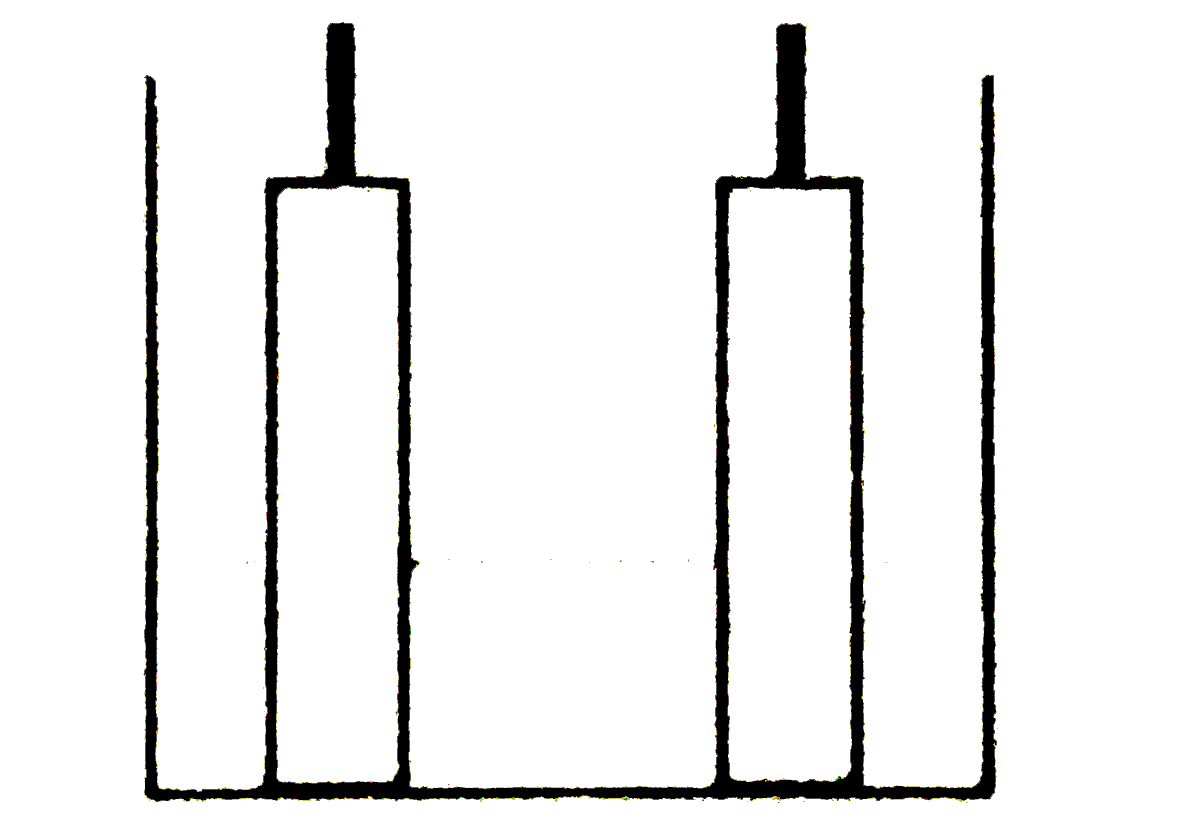 01:29View Solution
01:29View Solutionthe standard reduction potenital of a silver chloride electrode is 0.2 V and that of a silver electrode is 0.79 V. The maximum amount of AgCl that can dissolve in `10^(6)`L of a 0.1 M `AgNO_(3)` solution is:
02:02View SolutionCalcualte the cell EMP in mV for
`Pt|H_(2)(1 atm) | HCl(0.01 M)|| AgCl(s)| Ag(s)` at 298 K
If `DeltaG_(f)^(@)` values are at `25^(@)C`,
`-109.56 (kJ)/(mol) for AgCl(s)` and
`-130.79 (kJ)/(mol)` for `(H^(+) + Cl^(-)(aq)`, Take 1F = 96500 C05:33View SolutionCalculate the value of `Lambda_(m) ^prop` for `SrCl_(2)` in water at `25^(@)C` from the following data `:`
`{:(Conc. (mol//l t),,0.25,,1),(Lambda_(m)(Omega^(-1)cm^(2)mol^(-1)),,260,,250):}`02:25View SolutionSelect the correct statement if-
`E_(Mg^(2+)//Mg)^(@)=-2.4V, E_(Sn^(4+)//Sn^(2+))^(@)=0.1V, E_(MnO_(4)^(-),H^+//Mn^(2+))^(@)=1.5V, E_(I_(2)//I^(-))^(@)=0.5V`07:20View SolutionFor the cell (at 298K)
`Ag(s) | AgCl(s) | Cl^(-)(aq)|| AgNO_(3)(aq) | Ag(s)`
Which of the following is correct?02:49View SolutionPeroxodisulphate salts, `(e.g., Na_(2)S_(2)O_(8))` are strong oxidizing agents used be bleaching agents for fats, oils, ets.
Given `:`
`O_(2)(g)+4H^(o+)(aq)+4e^(-)rarr 2H_(2)O(l)" "E^(c-)=1.23V`
`S_(2)O_(8)^(2-)(aq)+2e^(-)rarr 2SO_(4)^(2-)(aq)" "E^(C-)=2.01V`
Which of the following statement is `(` are `)` correct ?04:02View SolutionIn which of the following cell(s): `E_("cell")=E_("cell")^(@)`?
01:52View SolutionA current of `2.68A` is passed for one hour through an aqeous solution of `CuSO_(4)` using copper electrodes. Select the correct statement (s) from the following
04:44View SolutionWhich is/are correct among the following? Given the half cell EMFs
`E_(Cu^(2+)//Cu)^(@)=0.337V, E_(Cu^(+)|Cu)^(@)=0.521V`01:44View SolutionMark out the correct statement(s) regarding electrolytic molar conductivity.
02:45View SolutionStatement-1:Zinc protect the iron better than tin even after it cracks.
Statement-2:`E_(OP_(Zn))^@ltE_(OP_(Fe))` But `E_(OP_(Sn))^@gtE_(OP_(Fe))`04:03View SolutionStatement-1: On increasing dilution, the specific conductance keeps on increasing.
Statement-2: On increasing dilution. Degree of ionization of weak electrolyte ncreases and mobility of ions also increases.01:27View SolutionStatement-1: For the reaction:
`Ni^(2+)+2e^(-)rarrNi` and `Fe^(2+)+2e^(-)rarrFe`
`rArr E_(Fe^(2+)|Fe)^(@)ltE_(Ni^(2+)|Ni)^(@)` and `E_("Red")^(@)gt0`
`rArr` So Fe electrode is cathode and Ni electrode is anode.
Statement-2: If `DeltaG^(@) lt0` and `E_("Cell")^(@)lt0`, then , cell is feasible.03:19View SolutionA fuel cell is a cell that is continously supplied with an oxidant and a reductant so that if can deliver a current indefinitely.
Fuel cells offer the possibility of achieving high thermodynamic efficiency in the conversion of Gibbs energy into mechanical work.Internal combustion engines at best convert only the fraction `(T_2-T_1)//T_2` of the heat of combustion into mechanical work.
While the thermodynamic efficiency of the fuel cell is given by, `eta=(DeltaG)/(DeltaH)`, where `DeltaG` is the Gibbs energy change for the cell reaction and `DeltaH` is the enthalpy change of the cell reaction.A hydrogen-oxygen fuel cell may have an acidic or alkaline electrolyte.
`Pt|H_2(g)|H^(+)(aq.)||H_2O(l)|O_(2)(g)|Pt , (2.303 RT)/F=0.06`
The above fuel cell is used to produce constant current supply under constant temperature & 30 atm constant total pressure conditions in a cylinder.If 10 moles `H_2` and 5 moles of `O_2` were taken initially.
Rate of consumption of `O_2` is 10 milli moles per minute. The half-cell reactions are
`1/2O_2(g)+2H^+(aq)+2e^(-)toH_2O(l) E^(@)=1.246 V`
`2H^+(aq)+2e^(-) to H_2(g) E^(@)=0`
To maximize the power per unit mass of an electrochemical cell, the electronic and electrolytic resistances of the cell must be minimized.Since fused salts have lower electolytic resistances than aqueous solutions, high-temperature electrochemical cells are of special interest for practical applications.
Calculate e.m.f of the given cell at t=0.(log 2=0.3)07:30View SolutionThe molar conductance of NaCl varies with the concentration as shown in the following table and all values follows the equation.
`lambda_(m)^(c)=lambda_(m)^(oo)-bsqrt(C)` where `lambda_(m)^(c)`= molar specific conductance `lambda_(m)^(oo)=` molar specific conductance at infinite dilution C=molar concentration

When a certain conductivity cell (C) was filled with 25`xx10^(-4)(M) NaCl` solution, the resistance of the cell was found to be 1000 ohm. At infinite dilution, conductance of `Cl^(-)` and `SO_(4)^(2-)` are `80ohm^(-1) cm^(2) "mole"^(-1)` and `160ohm^(-1) cm^(2) "mole"^(-1)` respectively.
What is the molar conductance of NaCl at infinite dilution?06:08View SolutionThe molar conductance of NaCl varies with the concentration as shown in the following table and all values follows the equation.
`lambda_(m)^(c)=lambda_(m)^(oo)-bsqrt(C)` where `lambda_(m)^(c)`= molar specific conductance `lambda_(m)^(oo)=` molar specific conductance at infinite dilution C=molar concentration

When a certain conductivity cell (C) was filled with 25`xx10^(-4)(M) NaCl` solution, the resistance of the cell was found to be 1000 ohm. At infinite dilution, conductance of `Cl^(-)` and `SO_(4)^(2-)` are `80ohm^(-1) cm^(2) "mole"^(-1)` and `160ohm^(-1) cm^(2) "mole"^(-1)` respectively.
What is the cell constant of the conductivity cell (C)?01:56View SolutionGiven : `E_(cu^(+2)//cu)^0=0.34 V`
`E_(Cl_2//Cl^(-))^0`=1.36 V
`E_(Br_2//Br^(-))^0=1.08 V`
`E_(l_2//l^(-))^0=0.54 V`
`{:("Column-I","Column-II"),((A)Cu^(+2)+2Cl to Cu+Cl_2, (p)"Can produce electricity in the galvanic cell"),((B)Cl_2+CutoCu^(+2)+2Cl^(-),(q)"Can be made to occur in electrolysis cell"),((C )2I^(-)+"starch solution + chlorine water",(r)"Appearance of brown colour"),((D)2Br^(-)+C Cl_4+"Chlorine water",(s)"Appearance of violet colour"):}`07:23View SolutionThe `E_(Call)^(@)=1.18V` for `Zn(s)||Zn^(+2)(1M)||Cu^(+2)(1M)|Cu(s)`. The value of `x` if when excess granulated zinc is added to `1M Cu^(+2)` solution the `[Cu^(+2)]_(eq)` becomes `10^(-x)M` is `(T=298 K ,(2.303RT)/(F)=0.059)`
03:10View SolutionA fuell cell uses `CH_(4)(g)` and forms `CO_(3)^(2-)` at the anode. It is used to power a car with 80 amp, for 0.96 hr. how many litres of `CH_(4)(g)` (at 1 atm, 273 K) would be required? (V_(m) = 22.4 L/mol) (F = 96500). Assume `100%` efficiency.
03:19View SolutionFor the cells in opposition,
Zn(s) | ZnCl_(2)(sol).|AgCl(s)|Ag|AgCl(s)|
`C-(1) = 0.02 M` , `ZnCl_(2)(sol)`| Zn(s)
`C_(2) = 0.5M`
Find out the emf (in millivolt) of the resultant cell. (take log 2 `=0.3,(RT)/F` at 298 K = 0.060)03:31View SolutionThe conductivity ofa solution may be taken to be directly proportional to the total concentration of the charge carriers (ions) present in it in many cases. Using the above, find the percent decrease in conductivity (k) of a solution of a week monoacidic base BOH when its 0.1 M solution is diluted to double its original volume. `(K_(b) = 10^(-5) for BOH) (take `sqrt(50) = 7.07`) (mark the answer to nearest integer)
02:21View SolutionAt 0.04 M concentration, the molar conductivity of solution of an electrolyte is `5000 Omega^(-1)cm^(2) mol^(-1)` while at 0.01 M concentration the value is `5100 Omega^(-1)cm^(2)mol^(-1)`. Making necessary assumption (Taking it as strong electrolyte) find the molar conductivity at infinite dilution and write percentage dissociation of strong electrolyte at 0.04 M.
03:23View SolutionCalculate `[H^+],[HCOO^(-)] and [OCN^(-)]` in a solution that contains 0.1 M HCOOH `(K_a=2.4xx10^(-4)) and 0.1 M HOCN (K_a=4xx10^(-4))`.
07:10View SolutionTo prepare a buffer solution of pH=4.04, amount of Barium acetate to be added to 100 mL of 0.1 M acetic acid solution `[pK_b(CH_(3)COO^(-))=9.26]` is:
02:20View SolutionFind the `DeltapH(` initial `pH -` final `pH)` when `100 ml 0.01M HCl` is added in a solution containing `0.1m` moles of `NaHCO_(3)` solution of negligible volume `(k_(a_(1))=10^(-7),k_(a_(2))=10^(-11)` for `H_(2)CO_(3)) :`
03:35View SolutionThe ionisation constant of benzoic acid `(PhCOOH)` is `6.46 xx 10^(-5)` and `K_(sp)` for silver benzoate is `2.5 xx 10^(-3)`. How many times is silver benzoate more soluble in a buffer of `pH 3.19` compared to its solubility is pure water?
06:02View SolutionWhen 100 mL of 0.1 M NaCN solution is titrated with 0.1 M HCl solution the variation of pH of solution with volume of HCl added will be :
02:03View SolutionThe indicator constant for an acidic indicator, `HIn` is `5xx10^(-6)M`. This indicator appears only in the colour of acidic form when `([In])/([HIn])le(1)/(20)` and it appears only in the colour of basic form when `([HIn])/([In])le(1)/(40)` . The pH range of indicator is `[` Given `: log 5=0.7]`
03:35View SolutionIonisation constant of HA (weak acid) and BOH (weak base) are `3.0xx10^(-7)` each at 298 K. the percentage extent of hydrolysis of BA at the dilution of 10 L is :
06:57View Solution`pOH=7-0.5pK_a+0.5 pK_b` is true for aqueous solution containing which pair of cation and anion :
03:16View SolutionAn acid-base indicator which is a weak acid has a `pK_(In)` value =5.45. At what concentration ratio of sodium acetate to acctic acid would the indicator show a colour half-way between those of its acid and conjugate base forms ?
`[pK_(a)` of acetic acid =4.75, log 2=0.3]02:16View SolutionA buffer solution is made by mixing a weak acid HA `(K_(a) =10^(-6))` with its salt NaA in equal amounts. What should be amount of acid or salt that should be added to make 90 mL of buffer solution in which if 0.1 mole of strong acid are added into 1 L of this buffer solution then change in pH is unity ?
08:26View SolutionWhich of the following solutions when added to 1L of a 0.1 M `CH_3COOH` or in the pH of the solution `K_a=1.8xx10^(-5)` for `CH_3COOH`?
06:41View SolutionSelect the correct statements:
03:36View SolutionBuffer soution'A' of a weak monoprotic acid and it's sodium salt in concentreaiton ration X:Y has `pH=(pH)_(1)` and buffer solution 'B' of the same acid and it's sodium salt in the concentration ratio Y:X has `pH=(pH)_(2). If (pH)_(2)-(pH)_(1)+ (pH)_(2)=9.5` units, then:
02:48View SolutionStatement-1 : 0.20 M solution of NaCN is more basic than 0.20 M solution of NaF.
Statement-2 :0.20 M solution of NaCN is more basic than 0.20 M solution of `CH_3COONa`04:30View SolutionAssertion : A substance that can either act as an acid a base is called ampholyte.
Reason : Bisulphide ion `(HS^(-))` and bicarbonate ion `(HCO_(3)^(-))` are ampholytes.02:43View SolutionConsider a solution of `CH_3COONH_4` which is a salt weak acid and weak base.
The equilibrium involved in the solutions are :
`CH_3COO^(-)+H_2OhArrCH_3COOH+OH^(-) " ........"(i)`
`NH_(4)^(+)+H_(2)hArrNH_(4)OH+H^(+)" ........"(ii)`
`H^(+)+OH^(-)hArrH_(2)O" ........"(iii)`
If we add these reactions, then the net reaction is :
`CH_(3)COO^(-)+H_(2)^(+)+H_(2)OhArrCH_(3)COOH+NH_(4)OH" ........"(iv)`
Both `CH_(3)COO^(-)`and `NH_(4)^(+)` get hydrolysed independently and their hydrolysis depends on :
(a) their initial concentration
(b) The value of `K_(h)` which is `(K_(w))/(K_(a))` for `CH_(3)COO^(-)` and `(K_(w))/(K_(b))` for `NH_(4)^(+)`.
Since both of the ions were produced form the salt, their initial concertration are same. Therefore, unless and until the value of `(K_(w))/(K_(a))` or `K_(a)` and `K_(b)` is same, the degree of hydrogen of ions can't be same.
To explain why we assume that degree of hydrolysis of cation and anion is same, we needed to now look at the third reaction i.e.,combination of `H^(+)` and `OH^(-)` ions. It is obvious that this reaction happens only because one reaction produced `H^(+)` ion and the other prodcued `OH^(-)` ions. We can also note that this reaction causes both the hydrolysis reaction to occur more since their product ions are being consumed. Keep this in mind that the equilibrium which has smaller value of the equilibrium constant is affected more by the common ion effect. For the same reason if for any reson a reaction is made to occur to a greater extent by the consumption of any of the prodcut ion, the reaction with the smaller value of equilibrium constant tends to get affected more.
Therefore, we conclude that firstly the hydroylsis of both the ions occurs more in the presence of each other (due to consumption of the product ions) than in each other's absence. Secondly,the hydroylsis of the ion which occurs to a lesser extent (due to smaller value of `K_(h))`is affected more than the one whole `K_(h)` is greater. Hence we can see that the degree of hydroylsis of both the ions would be close to each other when they are getting hyderolysed in the presence of each other.
In the hydrolysis of salt weak acid and weak base :11:54View SolutionConsider a solution of `CH_3COONH_4` which is a salt weak acid and weak base.
The equilibrium involved in the solutions are :
`CH_3COO^(-)+H_2OhArrCH_3COOH+OH^(-) " ........"(i)`
`NH_(4)^(+)+H_(2)hArrNH_(4)OH+H^(+)" ........"(ii)`
`H^(+)+OH^(-)hArrH_(2)O" ........"(iii)`
If we add these reactions, then the net reaction is :
`CH_(3)COO^(-)+H_(2)^(+)+H_(2)OhArrCH_(3)COOH+NH_(4)OH" ........"(iv)`
Both `CH_(3)COO^(-)`and `NH_(4)^(+)` get hydrolysed independently and their hydrolysis depends on :
(a) their initial concentration
(b) The value of `K_(h)` which is `(K_(w))/(K_(a))` for `CH_(3)COO^(-)` and `(K_(w))/(K_(b))` for `NH_(4)^(+)`.
Since both of the ions were produced form the salt, their initial concertration are same. Therefore, unless and until the value of `(K_(w))/(K_(a))` or `K_(a)` and `K_(b)` is same, the degree of hydrogen of ions can't be same.
To explain why we assume that degree of hydrolysis of cation and anion is same, we needed to now look at the third reaction i.e.,combination of `H^(+)` and `OH^(-)` ions. It is obvious that this reaction happens only because one reaction produced `H^(+)` ion and the other prodcued `OH^(-)` ions. We can also note that this reaction causes both the hydrolysis reaction to occur more since their product ions are being consumed. Keep this in mind that the equilibrium which has smaller value of the equilibrium constant is affected more by the common ion effect. For the same reason if for any reson a reaction is made to occur to a greater extent by the consumption of any of the prodcut ion, the reaction with the smaller value of equilibrium constant tends to get affected more.
Therefore, we conclude that firstly the hydroylsis of both the ions occurs more in the presence of each other (due to consumption of the product ions) than in each other's absence. Secondly,the hydroylsis of the ion which occurs to a lesser extent (due to smaller value of `K_(h))`is affected more than the one whole `K_(h)` is greater. Hence we can see that the degree of hydroylsis of both the ions would be close to each other when they are getting hyderolysed in the presence of each other.
For 0.1 M `CH_3COONH_(4)` salt solution given, `K_(a)(CH_(3)COOH)=K_(b)(NH_(4)OH)=2xx10^(-5)`.
In the case : degree of hydrolysis of cation and anion are :11:54View SolutionConsider a solution of `CH_3COONH_4` which is a salt weak acid and weak base.
The equilibrium involved in the solutions are :
`CH_3COO^(-)+H_2OhArrCH_3COOH+OH^(-) " ........"(i)`
`NH_(4)^(+)+H_(2)hArrNH_(4)OH+H^(+)" ........"(ii)`
`H^(+)+OH^(-)hArrH_(2)O" ........"(iii)`
If we add these reactions, then the net reaction is :
`CH_(3)COO^(-)+H_(2)^(+)+H_(2)OhArrCH_(3)COOH+NH_(4)OH" ........"(iv)`
Both `CH_(3)COO^(-)`and `NH_(4)^(+)` get hydrolysed independently and their hydrolysis depends on :
(a) their initial concentration
(b) The value of `K_(h)` which is `(K_(w))/(K_(a))` for `CH_(3)COO^(-)` and `(K_(w))/(K_(b))` for `NH_(4)^(+)`.
Since both of the ions were produced form the salt, their initial concertration are same. Therefore, unless and until the value of `(K_(w))/(K_(a))` or `K_(a)` and `K_(b)` is same, the degree of hydrogen of ions can't be same.
To explain why we assume that degree of hydrolysis of cation and anion is same, we needed to now look at the third reaction i.e.,combination of `H^(+)` and `OH^(-)` ions. It is obvious that this reaction happens only because one reaction produced `H^(+)` ion and the other prodcued `OH^(-)` ions. We can also note that this reaction causes both the hydrolysis reaction to occur more since their product ions are being consumed. Keep this in mind that the equilibrium which has smaller value of the equilibrium constant is affected more by the common ion effect. For the same reason if for any reson a reaction is made to occur to a greater extent by the consumption of any of the prodcut ion, the reaction with the smaller value of equilibrium constant tends to get affected more.
Therefore, we conclude that firstly the hydroylsis of both the ions occurs more in the presence of each other (due to consumption of the product ions) than in each other's absence. Secondly,the hydroylsis of the ion which occurs to a lesser extent (due to smaller value of `K_(h))`is affected more than the one whole `K_(h)` is greater. Hence we can see that the degree of hydroylsis of both the ions would be close to each other when they are getting hyderolysed in the presence of each other.
In a solution of `NaHCO_(3)`, the amphroximately same undergo ionization to form `H_(+)` ion and hydrolysis to form `OH^(-)` ion.
`HCO_(3)^(-)+H_(2)Ooverset("ionization")hArrCO_(3)^(2-)+H_(2)O`
`HCO_(3)^(-)+H_(2)Ooverset("hydrolysis")hArrH_(3)CO_(2)+OH^(-)`
To calculate ph, suitable approximation is :11:54View Solution`[H^(+)]` concentration in 0.01 M `H_2O_2` solution `(K_(a_(1))=3xx10^(-12) and K_(a_2)~~0)` is `xxM`.Fill first two digits of `10^(8)x` as answer.
05:02View SolutionCalculate the hydrogen ion concentration (`"in mol"//dm^3`) in a solution containing 0.04 mole of acetic acid and 0.05 mole of sodium acetate in 500 mL of solution.Dissociation constant for acetic acid is `1.75xx10^(-6)` Report your answer after multiplying by `2xx10^(6)`
04:13View SolutionThe vapour pressure of the solution of two liquids A`(P^@=80mm)`and B`(P^@=120mm)`is found to `100mm` when `x_(A)=0.4` .The result shows that
02:28View SolutionOsomotic pressure [in atm] of a 0.1 M solution of `K_4[Fe(CN)_6]`, which undergoes 50% dissociation, wil be ___ at `27^(@)C` :
05:03View SolutionWhich of the following has been arranged in order of decreasing freezing point ?
03:48View SolutionA solution of `x` moles of sucrose in `100`grams of water freeze at `-0.2^(@)C` As. Ice separates the freezing point goes down to `0.25^(@)C`. How many grams of ice would have separated ?
04:40View SolutionAvailable solutions are 1L of 0.1 M NaCl and 2L of 0.2 M `CaCl_2`.Using only these two solutions what maximum volume of a solution can be prepared having `[Cl^(-)]=0.34 M` exactly.Both electrolytes are strong
05:48View SolutionConsider equimolal aqueous solutions of `NaHSO_(4)` and NaCl with `DeltaT_(b)` and `DeltaT'_(b)` as their respective boiling point elevation . The value of `underset(m to1)("lim") (DeltaT_(b))/(DeltaT'_(b))` will be :
01:37View SolutionA solute S undergoes a reversible trimerization when dissolved in a certain solvent . The boiling point elevation of its `0.1` molal solution was found to be identical to be boiling point elevation in case of a `0.08` molal solution of a solute which neither undergoes association nor dissociation. To what percent had the solute S undergoes trimerization ?
03:20View SolutionFor a solution of 0.89 g of mercurous chloride in 50 g of `HgCl_(2)(l)` the freezing point depression id `1.24^(@)`C. `K_(f)` for `HgCl_(2)` is 34.3 . What is the state of mercurous chloride in `HgCL_(2)`? (Hg-200, Cl-35.5).
03:58View SolutionWhich of following statements are incorrect about Henry's law ?
05:04View SolutionIn which of the following pairs of solutions will the values of the vant Hoff factor be the same?
02:42View SolutionStatement-1 : Perfectly ideal solution is not possible with respect to binary solution of two liquids.
Statement :2 No two substances can have exactly the same nature of intermolecular forces & also of the same magnitude.02:33View SolutionStatement-1 : When a cell is placed in hypertonic solution, it shrinks.
Statement : 2 Reverse osmosis is used for desalination of water.06:48View SolutionStatement-1 : The difference in the boiling points of equimolar solution of `HCl` and `HF` decreases as their molarity is decreased.
Statement-2 : The extent of dissociation decreases steadily with increasing dilution.03:17View SolutionStatement-1 : When `'a'` ML of a `0.1` molal urea solution is mixed with another `'b'` mL of `0.1` molal glucose solution, the boiling point of the solution is no different from the boiling points of the boiling points of the samples prior to mixing but if `'a'` mL of `0.1` molal urea is mixed with `'b'` mL of `0.1` molal `HF` the boiling point of the mixture is different from the boiling points of the separate samples.
Staement-2 : `HF` is an electrolyte (weak) whereas glucose is a non electrolyte.03:31View SolutionIf osmotic presssure of 1M aqueous solution of `H_(2)SO_(4)` at 500 K is 90.2 atm. Calculate `K_(a2)` of `H_(2)SO_(4)`. Give your answer after multiplying 1000 with `K_(a_(2))`. (Assumme ideal solution) [Given : `K_(a_(1))` of `H_(2)SO_(4)=oo`,R=0.082 L atm`//`mol-K]
05:37View Solution`2.56g` of sulfur in `100 g` of `CS_(2)` of has depression in freez point of `0.01^(@)C.K_(f)=0.1^(@)` mol `al^(-1)`. Hence, he atomicity of sulfur is `CS_(2)` is
02:41View SolutionThe vapour pressure of fluorobenzene at `t^(@)` C is given by the equation
log p (mm Hg)= `7.0-(1250)/(t+220)`
Calculate the boiling point of the liquid in `C^(@)` if the external (applied) pressure is `5.26%` more than required for normal boiling point(log2=0.3)02:51View Solution1 g of arsenic dissolved in 86 g of benzene brings down the freezing point to `5.31^@C` from `5.50^@C`.If `K_f` of benzene is `4.9 (.^(@)C)/m`, the atomicity of the molecule is : (As =75 or As GAM 75)
05:29View SolutionAt a certain temperature, the first order rate constant `k_(1)` is found to be smaller than the second order rate constant `k_(2)`. If `E_(a)(1)` of the first order reaction is greater than `E_(a)(2)` of the second order reaction, then as temperature is raised:
04:30View SolutionA graph between `log t_((1)/(2))` and log a (abscissa), a being the initial concentration of A in the reaction For reaction `Ato`Product, the rate law is :
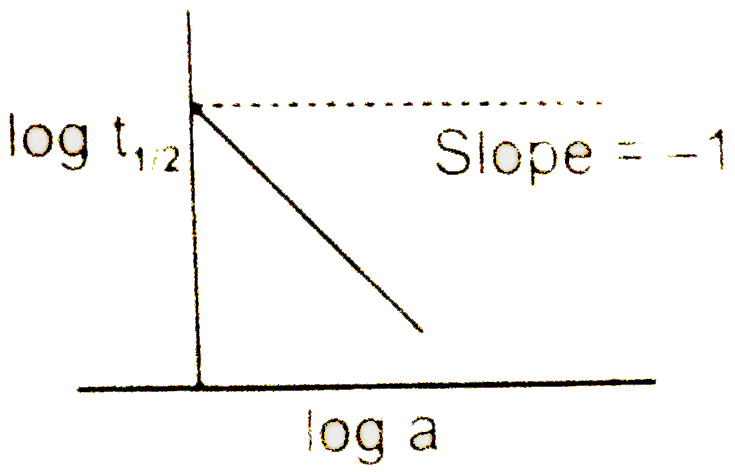 01:32View Solution
01:32View SolutionA gaseous reaction `A_(2)(g) rarr B(g) + (1)/(2) C(g)` shows increase in pressure form `100 mm` to `120 mm` in `5 min`. What is the rate of disappearance of `A_(2)` ?
03:30View SolutionFor a certain reaction the variation of rate constant with temperature is given by the equation
`ln k_(t) = lnk_(0) + ((ln 3)t)/(10) (t ge 0^(@)C)`
The value of temperature coefficient of the reaction is02:11View SolutionA reaction takes place in theee steps: the rate constant are `k_(1), k_(2), and k_(3)`. The overall rate constant `k=k_(1)k_(3)//k_(2)`. If the energies of activation are `40,30, and 20 KJ mol^(-1)`, the overall energy of activation is (assuming `A` to be constant for all)
04:31View SolutionIn a certain reaction, `10%` of the reactant decomposes in one hour, `20%` in two hours, `30%` in theee hours, and so on. The dimenison of the velocity constant (rate constant) are
03:37View SolutionSome graph are sketched for the reactant decomposes in one hour, 20% in two hours, 30% in three hours and so on. The dimensions of the rate constant is:

The order of reaction are respectively.05:20View SolutionCompounds A and B react with a common reagent with first order kinetics in both cases. If 99% of A must react before 1% of B has reacted, what is the minimum ratio for their respective rate constants ?
02:48View SolutionThe acitivity per ml of a solution of radioactive substances is x. How much of water be added to 200 ml of this solution so that the acitivity falls to `x//20` per ml after 4 half-lives ?
03:33View SolutionA reaction with respect to X is zero order till the concentration is reduced to half of initial concentration.Then this reaction become first order with respect to it.If the value of rate constants for the zero order and first order are equal to k (in magnitude), then find the time taken to reduce the concentration of X to `1/16th` of its original concentration `X_0`.
06:41View SolutionConsider the following statements and arrange in order of true/false as given in the codes.
`S_1`:The rate of the reaction `AtoB` having the rate law-`(d[A])/(dt)=k[A][B]` when plotted against time will exhibit a maximum at some time.
`S_2`:A catalyst in a chemical reaction increases the forward `E_a` and decreases the backward `E_a`
`S_3`: A catalyst in a chemical reaction decreases both forward and backward `E_a`
`S_4`:For a first-order reaction, the time required to reduce successively the concentration of reactant by a constant fraction is always same.06:39View SolutionFor the reaction `2A+BtoC` with the rate low `(d[C])/(dt)=k[A]^(1)[B]^(-1)` and started with A and B in stoichiometric proportion.Which is/are true ?
05:28View SolutionThe half-period T for the decomposition of ammonia on tungsten wire, was measured for different initial pressure P of ammonia at `25^@C`.Then
`{:("P(mm Hg)",11,21,48,73,120),("T(sec)",48,92,210,320,525):}`02:43View SolutionThe substance undergoes first order decomposition.The decomposition follows two parallel first order reactons as :
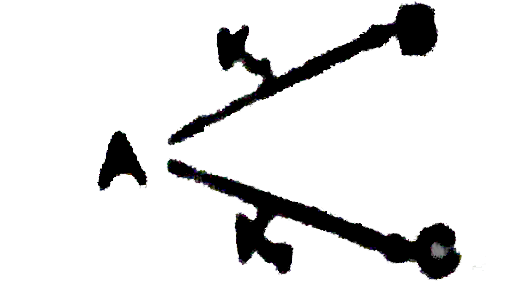
`K_1=10^(-2) sec^(-1) and K_2=10^(-2)sec^(-1)`
If the corresponding activation energies of parallel reaction are 100 and 120 kJ `"mol"^(-1)` then the net activation energy of A is/are:04:06View SolutionA certain reaction obeys the rate equation (in the integrated form) `[C^(1-n)-C_(@)^(1-n)]=(n-1) kt` where `C_@` is the initial concentration of C is the concentration after time, t Then:
04:57View SolutionA certain reaction `A rarr B` follows the given concentration (Molarity)-time graph. Which of the following statements is/are true?
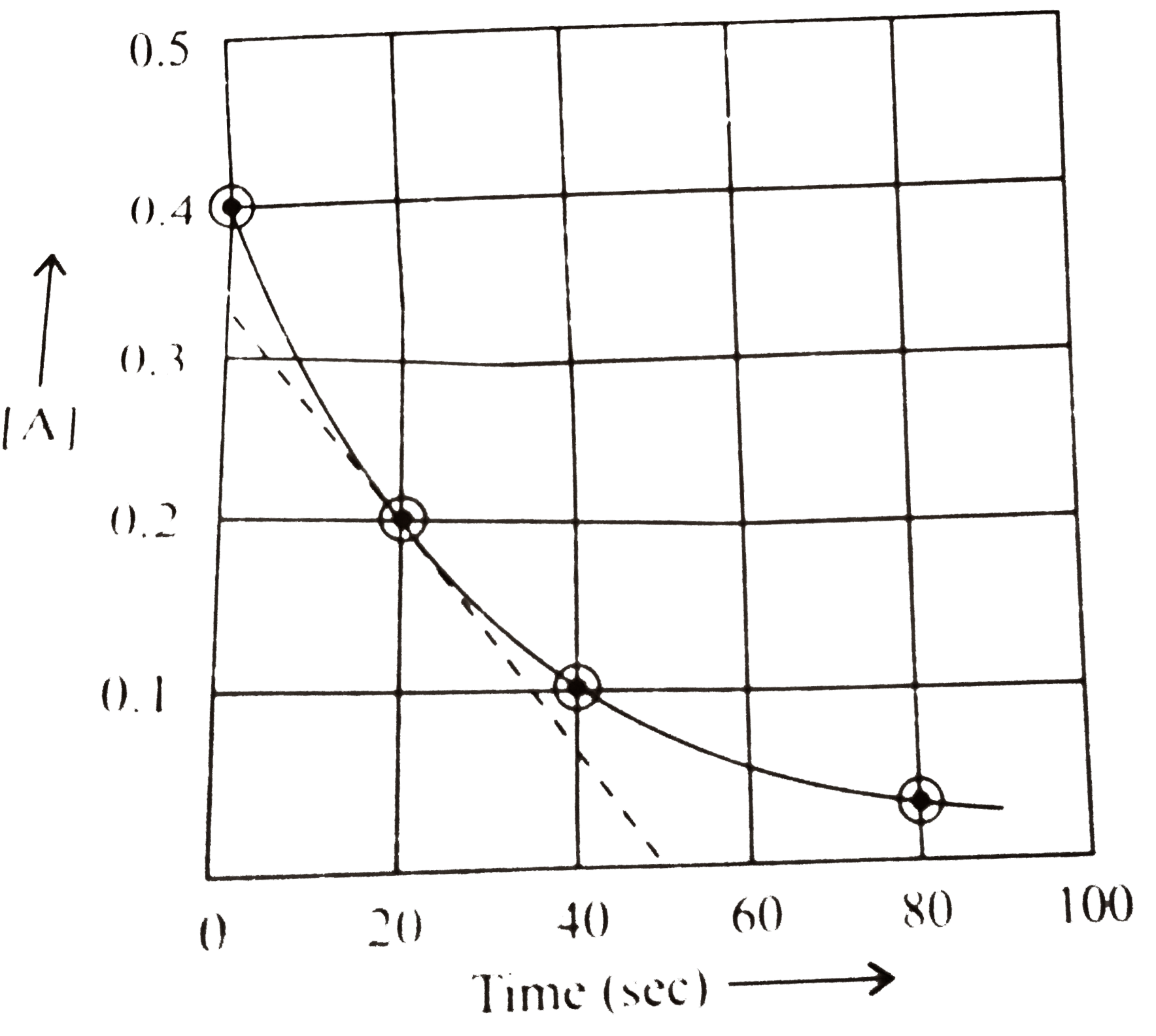 10:01View Solution
10:01View SolutionConsider the following case of competing `1^(st)` order reactions.
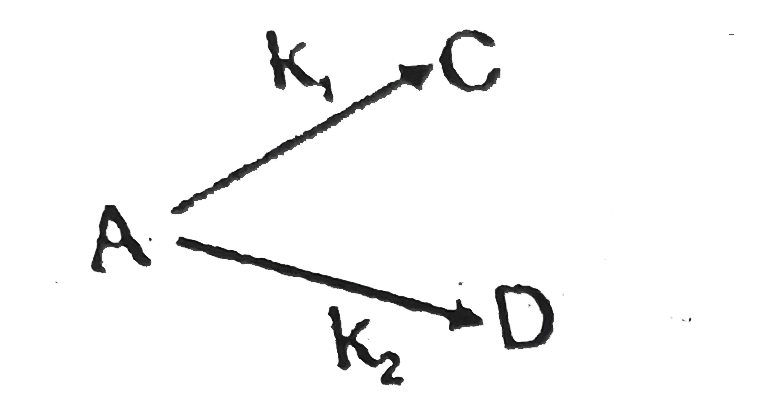
After the start of the reaction at t=0 with only A,the [C] is equal to the [D] at all time.The time in which all three concentrations wil be equal is given by :03:24View SolutionAssertion (A) : If the activation energy of a reaction is zero, temperature will have no effect on the rate constant. Reason (R ): Lower the activation energy, faster is the reaction.
02:05View SolutionThe rate law expresses the relationship of the rate of a reaction to the rate constant and the concentration of the reactants raised to some powers for the general reaction.
`aA+bBtocC+dD`
Rate law takes the form
`r=k[A]^(x)[B]^(y)`
where x and y are number that must be determined experimentely k is the rate constant and [A] and [B] are concentration of A & B respectively.
Gaseous reaction `AtoB+C` follows first order kinetics concentration of A changes from A changes from 1M to 0.25M in 138.6 min.Find the rate of reaction when conc. of A is 0.1 M.03:55View SolutionThe rate law expresses the relationship of the rate of a reaction to the rate constant and the concentration of the reactants raised to some powers for the general reaction.
`aA+bBtocC+dD`
Rate law takes the form
`r=k[A]^(x)[B]^(y)`
where x and y are number that must be determined experimentely k is the rate constant and [A] and [B] are concentration of A & B respectively.
The initial rate of zero order reaction of the gaseous equation `A(g)to2B (g)` is `10^(-2) M min^(-1)` If the initial concentration of A is 0.1 M what would be concentration of B after 60 seconds ?04:37View SolutionThe following data were observed for the following reaction at `25^(@)C, CH_(3)OH + (C_(6)H_(5))_(3)C Clrarr(C_(6)H_(5))_(3)C.OCH_(3)+HCl`
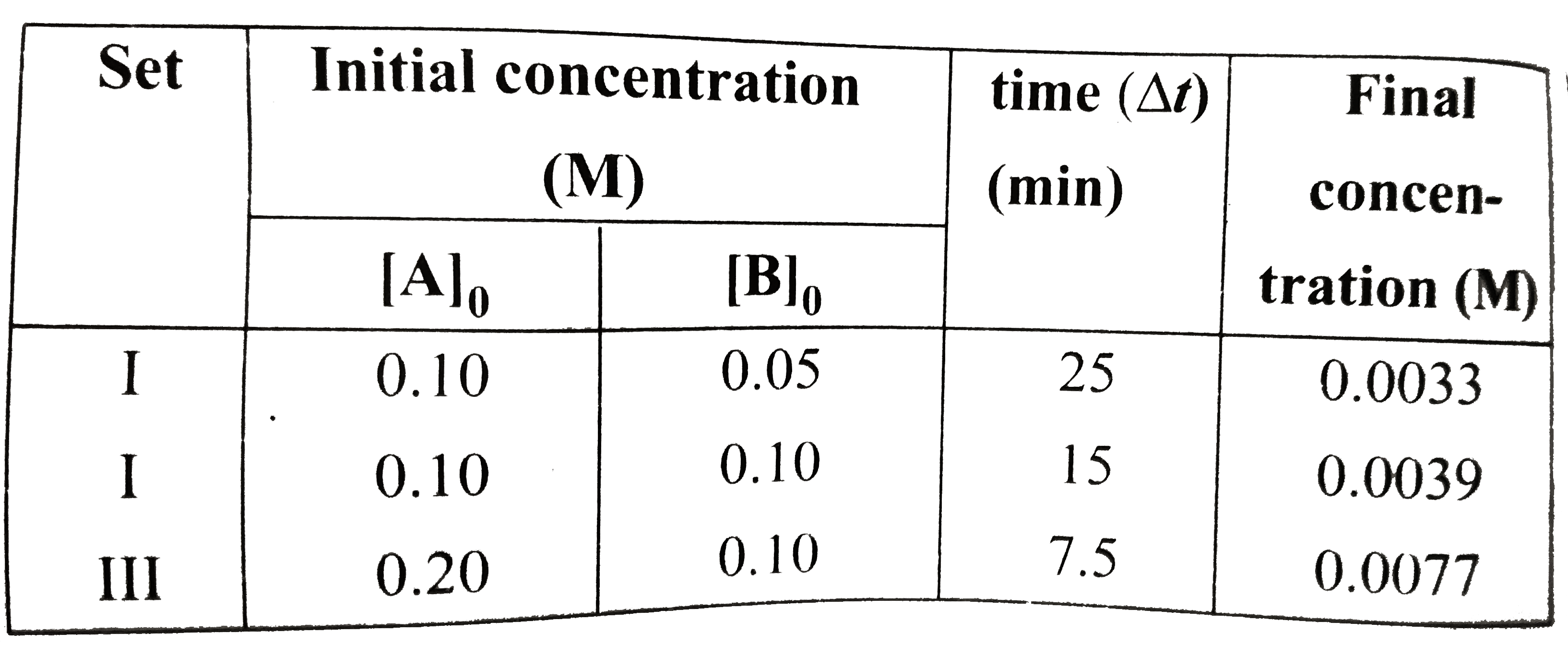
Rates `(d[C])/(dt)` in sets I, II, and III are, respectively,
(in `M min^(-1)`):08:36View SolutionThe following data were observed for the following reaction at `25^(@)C, CH_(3)OH + (C_(6)H_(5))_(3)C Clrarr(C_(6)H_(5))_(3)C.OCH_(3)+HCl`
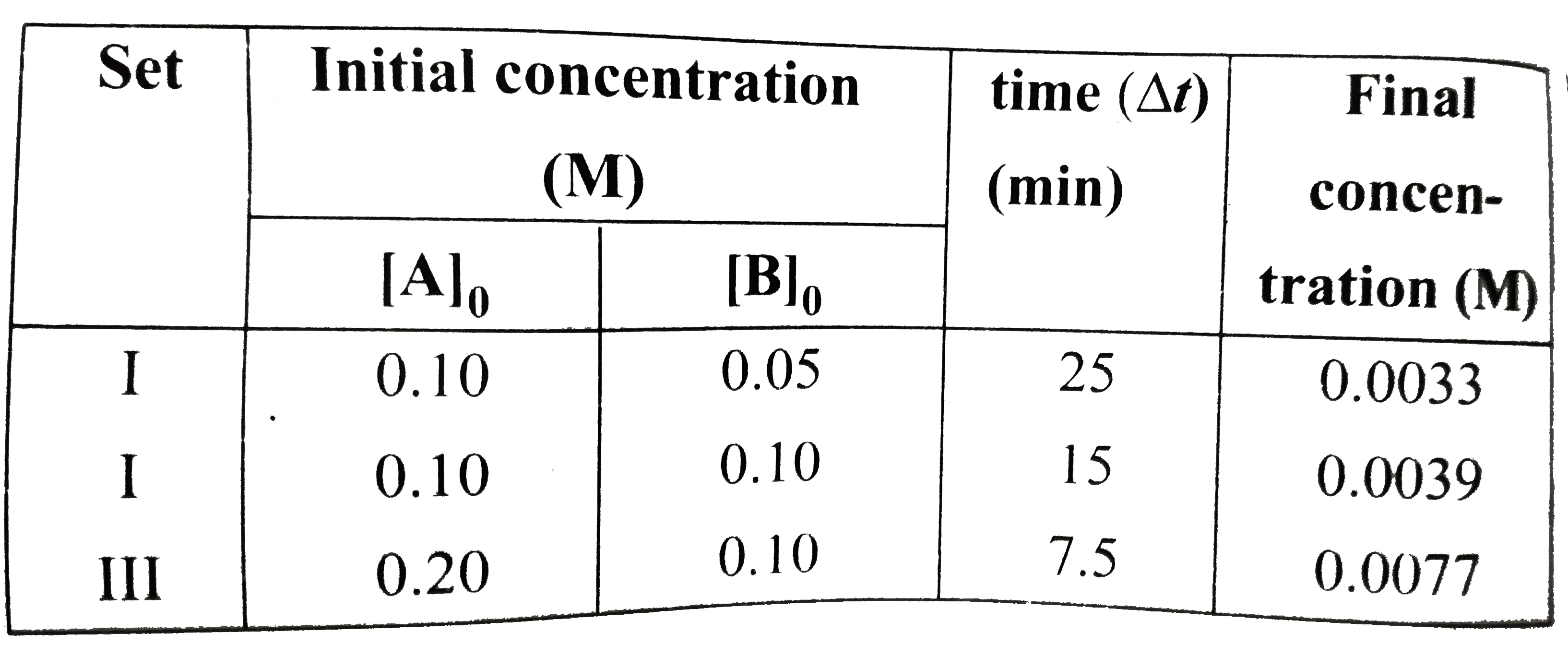
Rate law of the above experiment is08:36View SolutionThe following data were observed for the following reaction at `25^(@)C, CH_(3)OH + (C_(6)H_(5))_(3)C Clrarr(C_(6)H_(5))_(3)C.OCH_(3)+HCl`
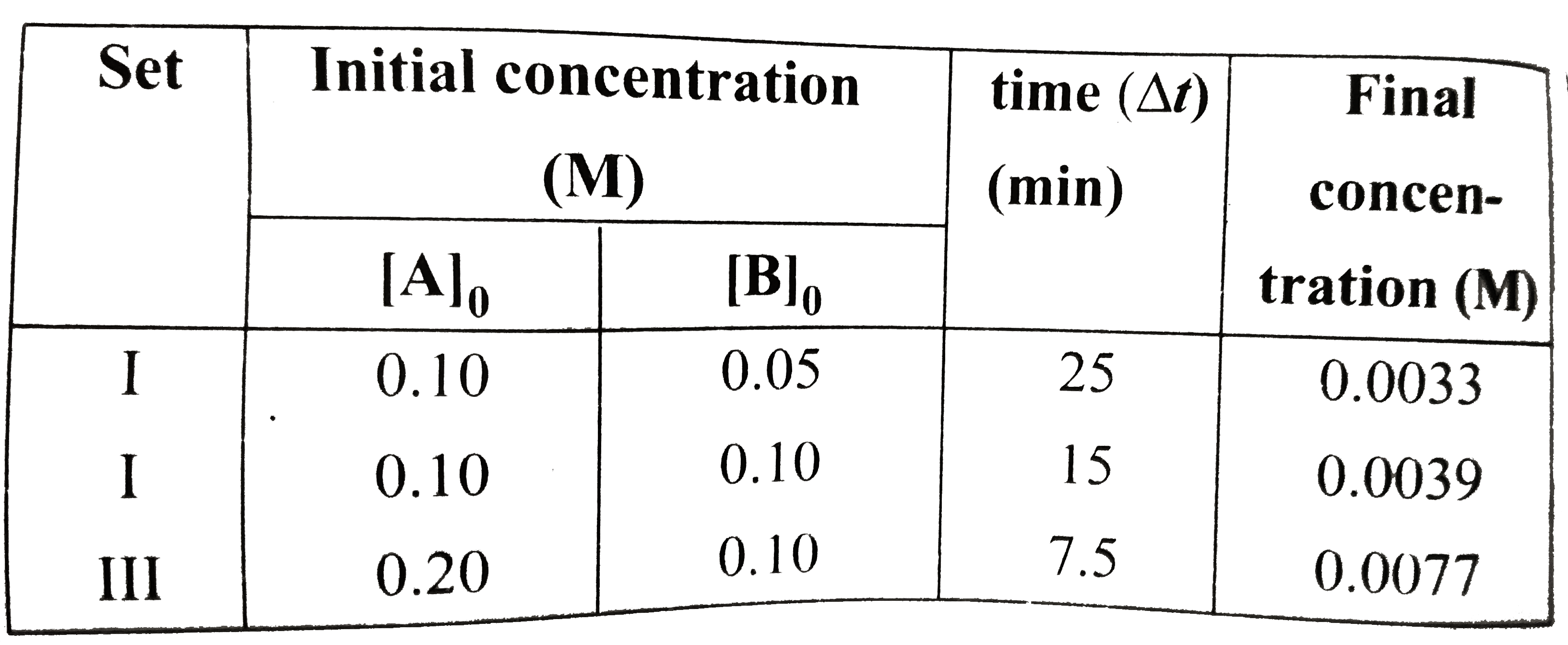
Rate constant of the above experiment is (in `L^(2) M^(-2) min^(-1)`) :08:36View SolutionMatch the following columns
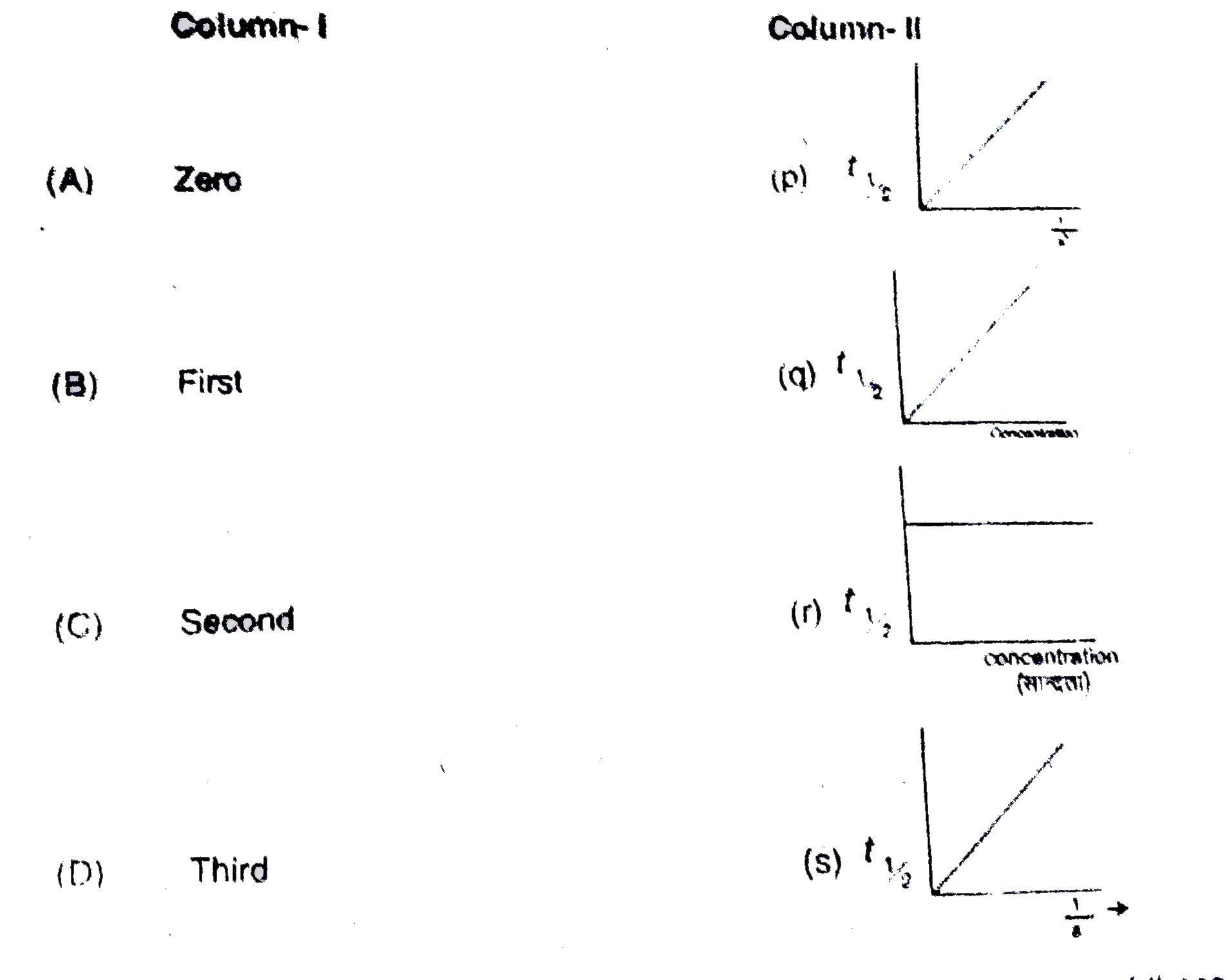 07:47View Solution
07:47View SolutionMatch order of the reaction (in List-I) with the corresponding rate constant (in List II).
`{:("List I (order)","List II (rate constant)"),((A)"Zero",(p)K=1/(2t)[1/((a-x)^2)-1/a^2]),((B)"First",(q)K=1/(t)[1/((a-x))-1/a]),((C )"Second",(r)k=x/t),((D)"Third",(s)k=1/t"log"_e(1/(a-x))):}`04:57View SolutionFor the reaction `Ato` prouducts, the following data is given for a particular run.
`{:("time(min.):",0,5,15,25),(1/([A])(M-1):,1,2,4,8):}`
Determine the order of the reaction.03:19View SolutionIf `(dx)/(dt)=k[H_(3)O^(+)]n`
and rate becomes 100 times when pH changes from 2 to 1 Hence order of reactions is03:07View SolutionThe gas phase decomposition of dimethyl ether follows first order kinetics.
`CH_(3)-O-CH_(3)(g)rarrCH_(4)(g)+H_(2)(g)+CO(g)`
The reaction is carried out in a constant volume container at `500^(@)C` and has a half life of `14.5 min`. Initially, only dimethyl ether is present at a pressure `0.40 atm`. What is the total pressure of the system after `12min`? (Assume ideal gas behaviour)04:25View Solution`105 mL` of pure water at `4^(circ)C` saturated with `NH_(3)` gas yielded a solution of density `0.9g mL^(-1)` and containing `30%NH_(3)` by mass. Find out the volume of `NH_(3)` solution resulting and the volume of `NH_(3)` gas at `4^(circ)C` and `775 mm` of `Hg`, which was used to saturate water.
04:55View SolutionVolume `V_(1)mL` of 0.1 M `K_(2)Cr_(2)O_(7)` is needed for complete oxidation of 0.678g `N_(2)H_(4)` in acidic medium. The volume of 0.3M `KMnO_(4)` needed for same oxidation in acidic medium will be :
02:20View Solution100 ml of 0.1 M `NaAl(OH)_(2)CO_3` is neutralised by 0.25 N HCl to form `NaCl, AlCl_3` and `CO_2`.Volume of HCl required is
03:01View Solution
All Questions questions and complete solutions for chapter RANK BOOSTER of PHYSICAL, INORGANIC, AND ORGANIC CHEMISTRY of Class 12
